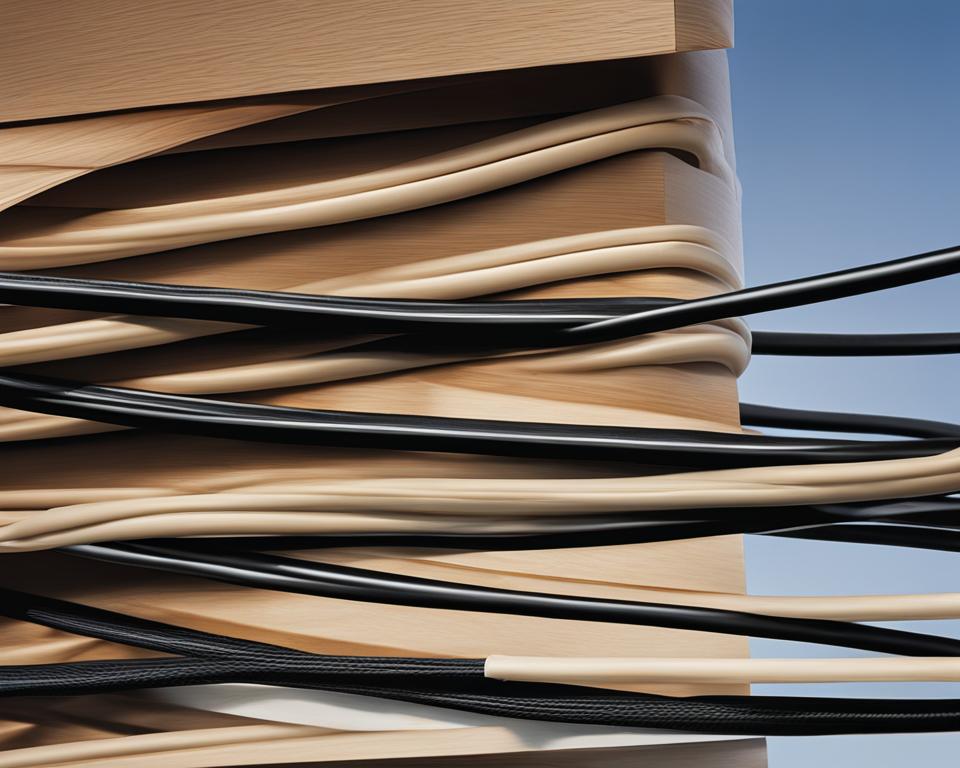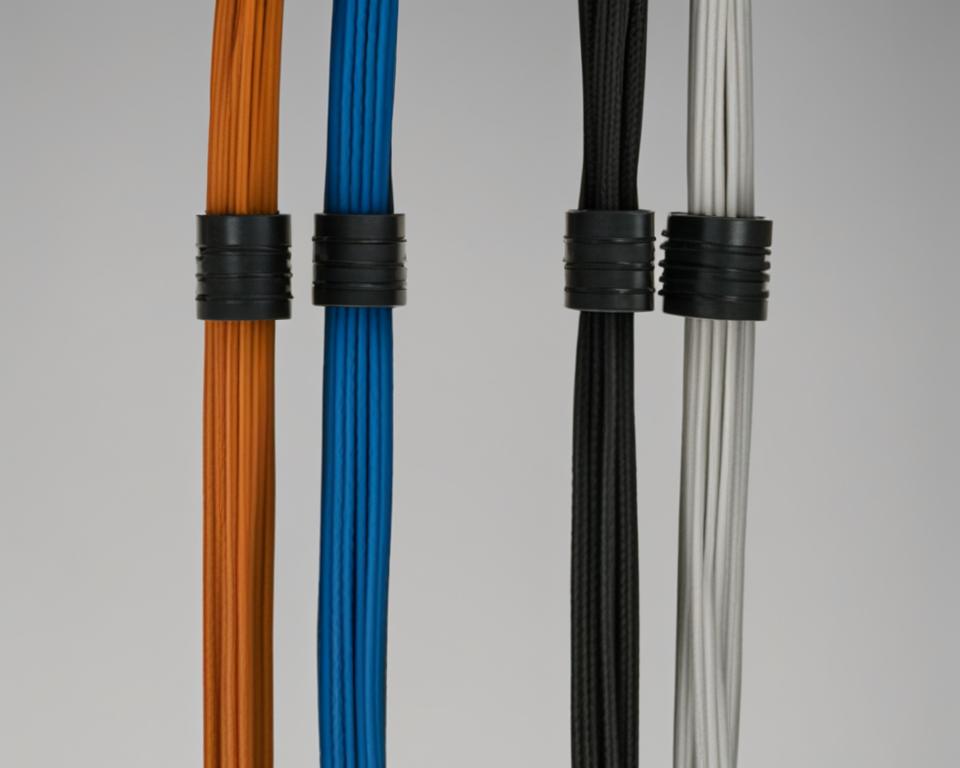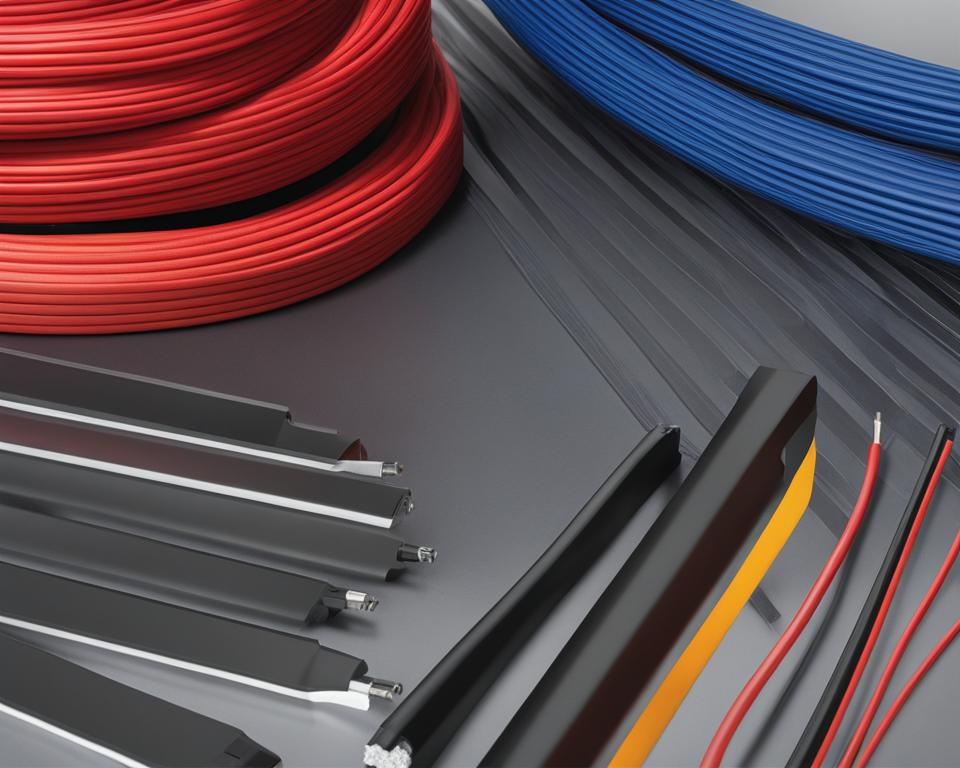Welcome to our comprehensive guide on comparing Loomex and Romex, two popular types of electrical cables used in residential applications. When it comes to electrical wiring, choosing the right cable is crucial for ensuring a safe and efficient electrical system. In this guide, we’ll explore the differences between Loomex and Romex, their characteristics, benefits, and considerations for various applications. Whether you’re a homeowner or a professional electrician, this guide will help you make an informed decision about which cable is best suited for your electrical wiring needs.
Key Takeaways:
- Understand the differences between Loomex and Romex electrical cables.
- Learn about NM sheathed cable and its components.
- Discover the characteristics and specifications of Romex.
- Explore the advantages of Loomex wiring for residential applications.
- Consider the appropriate use and locations for Loomex and Romex cables.
Now, let’s dive into the details and compare Loomex and Romex to help you make an informed decision for your electrical system.
Understanding NM Sheathed Cable
NM sheathed cable, such as Romex and Loomex, is a type of electrical cable commonly used in residential wiring. It consists of an outer sheathing, wire insulation, and individual wires (conductors).
The outer sheathing is a tough PVC jacket that protects the bundle of individual wire conductors. This durable sheathing provides excellent protection against physical damage and helps to prevent moisture penetration. It also adds insulation to the cable, reducing the risk of electric shock.
The individual wires are insulated with color-coded PVC, typically in black, white, and red insulation. This color-coding system makes it easy to identify and connect the wires correctly during installation. The insulation also provides further protection against electrical current and heat.
One of the essential components of NM sheathed cable is the copper grounding wire. The grounding wire is crucial for safety, as it helps to redirect electrical current in the event of a fault or short circuit.
The conductors in NM sheathed cable are made of soft, uncoated copper. Copper is an excellent conductor of electricity, ensuring efficient flow of electrical current through the cable. The cable is available in various wire gauges, allowing for flexibility in choosing the appropriate size for different electrical applications.
Overall, NM sheathed cable, such as Romex and Loomex, provides a reliable and versatile solution for residential electrical wiring. Its combination of strong sheathing, insulation, individual wires, and grounding capabilities ensures safe and efficient electrical conductivity.
Characteristics of Romex
Romex is a brand of NM sheathed cable manufactured by Southwire Company. It is widely recognized as the primary choice for NM wire in North America. Romex is highly regarded for its exceptional quality and reliability in electrical installations. Let’s take a closer look at the key characteristics that make Romex a preferred option for residential applications:
Durable Outer Sheathing
The outer sheathing of Romex is made of sturdy PVC (polyvinyl chloride) material. This robust protective layer safeguards the cable from physical damage and external elements, ensuring long-lasting performance.
Copper Conductors
The individual conductors within Romex are manufactured using high-quality copper wire. Copper is known for its excellent conductivity, allowing for efficient electrical flow and reducing power losses.
Color-Coded Insulation
Romex cables incorporate color-coded insulation for easy identification and proper connections. The insulation, typically in black, white, and red, simplifies the installation process and enhances safety.
Wire Gauges
Romex cables are available in various wire gauges to accommodate different electrical requirements. The wire gauge refers to the thickness of the conductors, with lower gauge numbers indicating thicker wires. Common wire gauge sizes include 14, 12, and 10, among others.
Cable Labels and Specifications
Romex cables feature clear and accurate cable labels that indicate the gauge and number of conductors present. For instance, a cable labeled “14-2 with ground” would consist of two insulated conductors with 14-gauge wires and an additional bare copper grounding wire for safety and compliance. These cable specifications adhere to electrical codes and standards, ensuring reliable and code-compliant installations.
Overall, Romex stands as a trusted and widely used brand of NM sheathed cable due to its resilient construction, quality copper conductors, color-coded insulation, flexibility in wire gauge options, and adherence to cable labeling and specifications. These factors make Romex an ideal choice for a range of residential electrical applications.

Benefits of Loomex Wiring
Loomex wiring, also known as NM sheathed cable, offers several advantages for residential wiring. Here are some key benefits of using Loomex wiring:
1. Installation in Plastic Boxes
Loomex wiring can be installed in plastic boxes, eliminating the need for grounding the box itself. This simplifies the installation process and saves time and effort.
2. Lightweight and Easy to Handle
Compared to metal-sheathed wiring, Loomex is much lighter, making it easier to handle and unspool during installation. The lightweight nature of Loomex wiring reduces the strain on electricians and ensures a smoother installation process.
3. Easy to Pull and Cut
The smooth PVC sheathing of Loomex wiring allows for easy pulling through holes in studs. The added coating on Romex makes it even more slippery, further facilitating its installation. Additionally, Loomex wiring is easy to cut, allowing for precise and efficient installation.
4. Cost-Effective Option
Loomex wiring is cheaper than metal-sheathed wiring, making it a cost-effective choice for residential projects. It provides the same level of functionality and safety as metal-sheathed wiring but at a lower cost.
5. Easy to Rip and Attach
Thanks to its design, Loomex wiring is easy to rip when needed and attach to framing members. Electricians can use lightweight plastic cable staples to secure the wiring, ensuring a secure and professional installation.
Overall, Loomex wiring offers numerous benefits for residential wiring, including easy installation in plastic boxes, lightweight design, ease of handling, pulling, cutting, and attachment, as well as cost-effectiveness. These advantages make Loomex wiring an attractive option for electricians and homeowners alike.

Comparing Loomex and Romex
When comparing Loomex and Romex, it’s important to consider their similarities and differences. Both cables are types of NM sheathed cable and have similar applications in residential wiring. However, there are some key differences to note.
Applications
Both Loomex and Romex are commonly used for residential wiring applications. They are suitable for creating separate circuits for electrical devices within homes.
Durability
While both cables are durable, Romex tends to be more robust. It is designed to withstand more challenging installations and is better suited for pulling through difficult passages due to its more slippery coating.
Outdoor Use and Suitable Locations
Loomex is generally considered more suitable for indoor use due to its PVC sheathing. It is not recommended for outdoor applications or in certain locations where it may be exposed to moisture. On the other hand, Romex can be used both indoors and outdoors and is better equipped to handle environments with higher levels of humidity or dampness.
| Loomex | Romex | |
|---|---|---|
| Indoor Use | ✅ | ✅ |
| Outdoor Use | ❌ | ✅ |
| Suitable for Moisture-Prone Locations | ❌ | ✅ |
When it comes to choosing between Loomex and Romex, it’s crucial to consult electrical codes and regulations to ensure compliance and determine the appropriate cable for specific applications. The selection should be based on the specific needs, durability requirements, and suitable locations of the electrical system.

“The key to making an informed choice between Loomex and Romex is understanding their applications and durability. By considering factors such as indoor or outdoor use and the specific locations where the cable will be installed, you can ensure a safe and reliable electrical wiring system.”
Conclusion
In conclusion, when it comes to residential electrical wiring, both Loomex and Romex are popular choices. They are both types of NM sheathed cable that share similar characteristics. However, there may be slight differences in terms of their applications and durability.
Loomex wiring offers several advantages for homeowners. It is known for its ease of installation, thanks to its lightweight design. Additionally, Loomex wiring is cost-effective, making it a budget-friendly option for residential projects.
On the other hand, Romex is a trusted brand with a reputation for quality and reliability. It is widely used and known for meeting electrical codes and regulations. When choosing between Loomex and Romex, it’s crucial to consider factors such as the specific application, location, and compliance with electrical codes.
Ultimately, the decision between Loomex and Romex should be based on the specific needs and requirements of the electrical system. By evaluating these factors, homeowners can make an informed choice and ensure the safety and efficiency of their electrical wiring.
FAQ
What is the difference between Loomex and Romex?
Loomex and Romex are both types of NM sheathed cable used in residential wiring. Loomex is a specific brand of cable made by Southwire Company, while Romex is a generic term often used to describe any brand of NM-sheathed electrical wire. However, technically, Romex refers to the cable made by Southwire.
What is NM sheathed cable?
NM sheathed cable, also known as non-metallic sheathed cable, is a type of electrical cable commonly used in residential wiring. It consists of an outer sheathing, wire insulation, and individual wires (conductors). The sheathing is made of PVC and protects the individual wires. The conductors are made of copper and are insulated with color-coded PVC.
What are the characteristics of Romex?
Romex is a brand of NM sheathed cable made by Southwire Company. It is known for its high quality and reliability. Romex features an outer sheathing made of PVC, individual copper conductors, and color-coded insulation. The cable comes in various wire gauges, with different cable labels indicating the gauge and number of conductors.
What are the benefits of Loomex wiring?
Loomex wiring, also known as NM sheathed cable, has several advantages for residential wiring. It can be installed in plastic boxes, eliminating the need to ground the box itself. Loomex is lighter and easier to handle than metal-sheathed wiring. The smooth PVC sheathing allows for easy pulling through holes in studs. Loomex wiring is also easier to cut and attach to framing members using lightweight plastic cable staples. Additionally, Loomex wiring is generally cheaper than metal-sheathed wiring.
How do Loomex and Romex compare?
Loomex and Romex are both types of NM sheathed cable used in residential wiring. They have similar applications but some differences. Loomex is generally considered more suitable for indoor use due to its PVC sheathing, while Romex has a more slippery coating that makes it better for pulling through difficult passages. Loomex is not as durable as Romex and is not recommended for outdoor use or in locations exposed to moisture.
What should I consider when choosing between Loomex and Romex?
When choosing between Loomex and Romex, consider factors such as the specific application, location, and compliance with electrical codes and regulations. Loomex offers advantages such as ease of installation, lightweight design, and cost-effectiveness. Romex, as a trusted brand, is known for its quality and reliability. Ultimately, the decision should be based on the specific needs and requirements of the electrical system.
